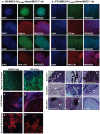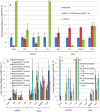MUC1* ligand, NM23-H1, is a novel growth factor that maintains human stem cells in a more naïve state
- PMID: 23505541
- PMCID: PMC3591366
- DOI: 10.1371/journal.pone.0058601
MUC1* ligand, NM23-H1, is a novel growth factor that maintains human stem cells in a more naïve state
Abstract
We report that a single growth factor, NM23-H1, enables serial passaging of both human ES and iPS cells in the absence of feeder cells, their conditioned media or bFGF in a fully defined xeno-free media on a novel defined, xeno-free surface. Stem cells cultured in this system show a gene expression pattern indicative of a more "naïve" state than stem cells grown in bFGF-based media. NM23-H1 and MUC1* growth factor receptor cooperate to control stem cell self-replication. By manipulating the multimerization state of NM23-H1, we override the stem cell's inherent programming that turns off pluripotency and trick the cells into continuously replicating as pluripotent stem cells. Dimeric NM23-H1 binds to and dimerizes the extra cellular domain of the MUC1* transmembrane receptor which stimulates growth and promotes pluripotency. Inhibition of the NM23-H1/MUC1* interaction accelerates differentiation and causes a spike in miR-145 expression which signals a cell's exit from pluripotency.
Conflict of interest statement
Figures








Similar articles
-
The case for extracellular Nm23-H1 as a driver of acute myeloid leukaemia (AML) progression.Naunyn Schmiedebergs Arch Pharmacol. 2015 Feb;388(2):225-33. doi: 10.1007/s00210-014-1027-8. Epub 2014 Aug 15. Naunyn Schmiedebergs Arch Pharmacol. 2015. PMID: 25119778 Review.
-
MUC1* mediates the growth of human pluripotent stem cells.PLoS One. 2008 Oct 3;3(10):e3312. doi: 10.1371/journal.pone.0003312. PLoS One. 2008. PMID: 18833326 Free PMC article.
-
Nm23-h1 indirectly promotes the survival of acute myeloid leukemia blast cells by binding to more mature components of the leukemic clone.Cancer Res. 2011 Feb 1;71(3):1177-86. doi: 10.1158/0008-5472.CAN-10-1704. Epub 2010 Dec 17. Cancer Res. 2011. PMID: 21169412
-
Undifferentiated propagation of the human embryonic stem cell lines, H1 and HSF6, on human placenta-derived feeder cells without basic fibroblast growth factor supplementation.Stem Cells Dev. 2010 Nov;19(11):1713-22. doi: 10.1089/scd.2010.0014. Epub 2010 Sep 9. Stem Cells Dev. 2010. PMID: 20201681
-
Regulatory functions of Nm23-H2 in tumorigenesis: insights from biochemical to clinical perspectives.Naunyn Schmiedebergs Arch Pharmacol. 2015 Feb;388(2):243-56. doi: 10.1007/s00210-014-1066-1. Epub 2014 Nov 21. Naunyn Schmiedebergs Arch Pharmacol. 2015. PMID: 25413836 Review.
Cited by
-
The Subcellular Localization and Oligomerization Preferences of NME1/NME2 upon Radiation-Induced DNA Damage.Int J Mol Sci. 2020 Mar 29;21(7):2363. doi: 10.3390/ijms21072363. Int J Mol Sci. 2020. PMID: 32235358 Free PMC article.
-
MUC1: a multifaceted oncoprotein with a key role in cancer progression.Trends Mol Med. 2014 Jun;20(6):332-42. doi: 10.1016/j.molmed.2014.02.007. Epub 2014 Mar 22. Trends Mol Med. 2014. PMID: 24667139 Free PMC article. Review.
-
Effective CAR T-cell targeting of an MUC1 cleavage product.J Immunother Cancer. 2025 May 30;13(5):e010577. doi: 10.1136/jitc-2024-010577. J Immunother Cancer. 2025. PMID: 40447312 Free PMC article.
-
Extracellular NME proteins: a player or a bystander?Lab Invest. 2018 Feb;98(2):248-257. doi: 10.1038/labinvest.2017.102. Epub 2017 Oct 16. Lab Invest. 2018. PMID: 29035383 Review.
-
The case for extracellular Nm23-H1 as a driver of acute myeloid leukaemia (AML) progression.Naunyn Schmiedebergs Arch Pharmacol. 2015 Feb;388(2):225-33. doi: 10.1007/s00210-014-1027-8. Epub 2014 Aug 15. Naunyn Schmiedebergs Arch Pharmacol. 2015. PMID: 25119778 Review.
References
-
- Nelson TJ, Martinez-Fernandez A, Terzic A (2010) Induced pluripotent stem cells: developmental biology to regenerative medicine. Nat Rev Cardiol 7: 700–710. - PubMed
-
- Nishikawa S-i, Goldstein RA, Nierras CR (2008) The promise of human induced pluripotent stem cells for research and therapy. Nat Rev Mol Cell Biol 9: 725–729. - PubMed
-
- Ludwig T, Thomson JA (2007) Defined, feeder-independent medium for human embryonic stem cell culture. Curr Protoc Stem Cell Biol Chapter 1: Unit 1C 2 - PubMed
-
- Unger C, Skottman H, Blomberg P, Dilber MS, Hovatta O (2008) Good manufacturing practice and clinical-grade human embryonic stem cell lines. Hum Mol Genet 17: R48–53. - PubMed
Publication types
MeSH terms
Substances
LinkOut - more resources
Full Text Sources
Other Literature Sources
Medical
Research Materials
Miscellaneous

